Abstract
The intraperitoneal injection of insulin-producing islets immunoprotected by an alginate-poly(amino acid) membrane is a potential method of reversing diabetes without the need for lifelong immunosuppression. Previous attempts to demonstrate this technology in large animals have failed, preventing application in humans. We have determined that key factors responsible for these past failures include cytokine (interleukins 1 and 6 and tumor necrosis factor) stimulation by mannuronic acid monomers from alginate capsules with weak mechanical integrity, which results in fibroblast proliferation. With this insight, we formulated mechanically stable microcapsules by using alginate high in guluronic acid content and report prolonged reversal of diabetes in the spontaneous diabetic dog model by the intraperitoneal injection of encapsulated canine islet allografts. Euglycemia, independent of any exogenous insulin requirement, was noted for up to 172 days. Graft survival, evidenced by positive C-peptide release, was noted for as long as 726 days in a recipient receiving a single injection of immunoprotected islets. Histological evidence of viable islets retrieved from the peritoneal cavity 6 months posttransplant confirmed the biocompatibility and immunoprotective nature of this capsule formulation. The finding that intraperitoneal injection of alginate-immunoprotected islets, a minimally invasive surgical procedure, is effective in prolonged (> 1 year) maintenance of glycemic control, without the need for lifelong immunosuppression, may have significant implications for the future therapy of type I diabetes in humans.
Full text
PDF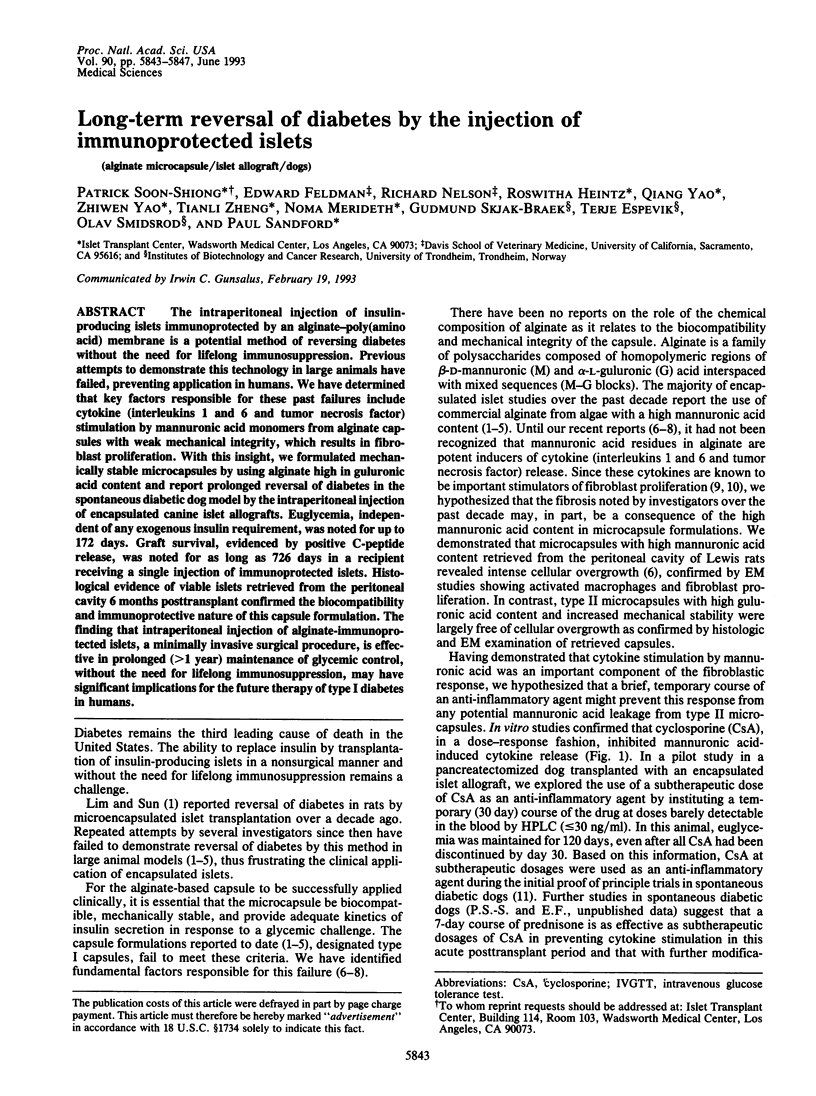
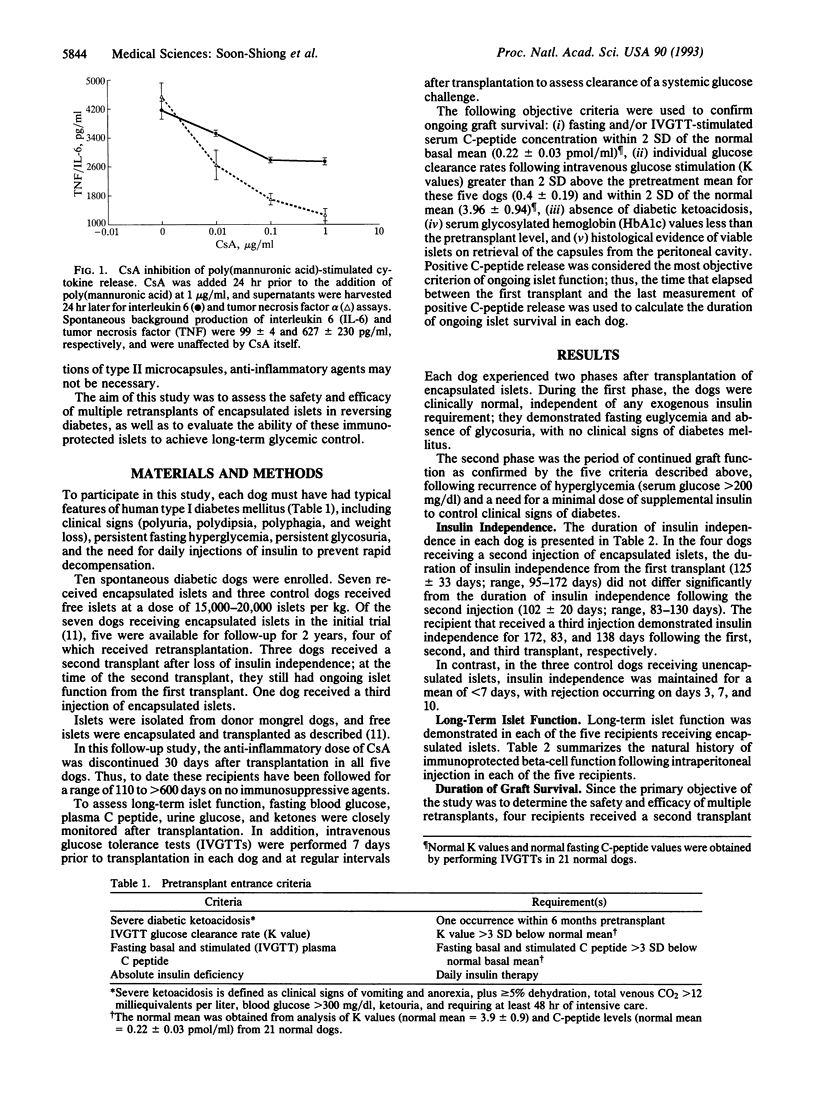
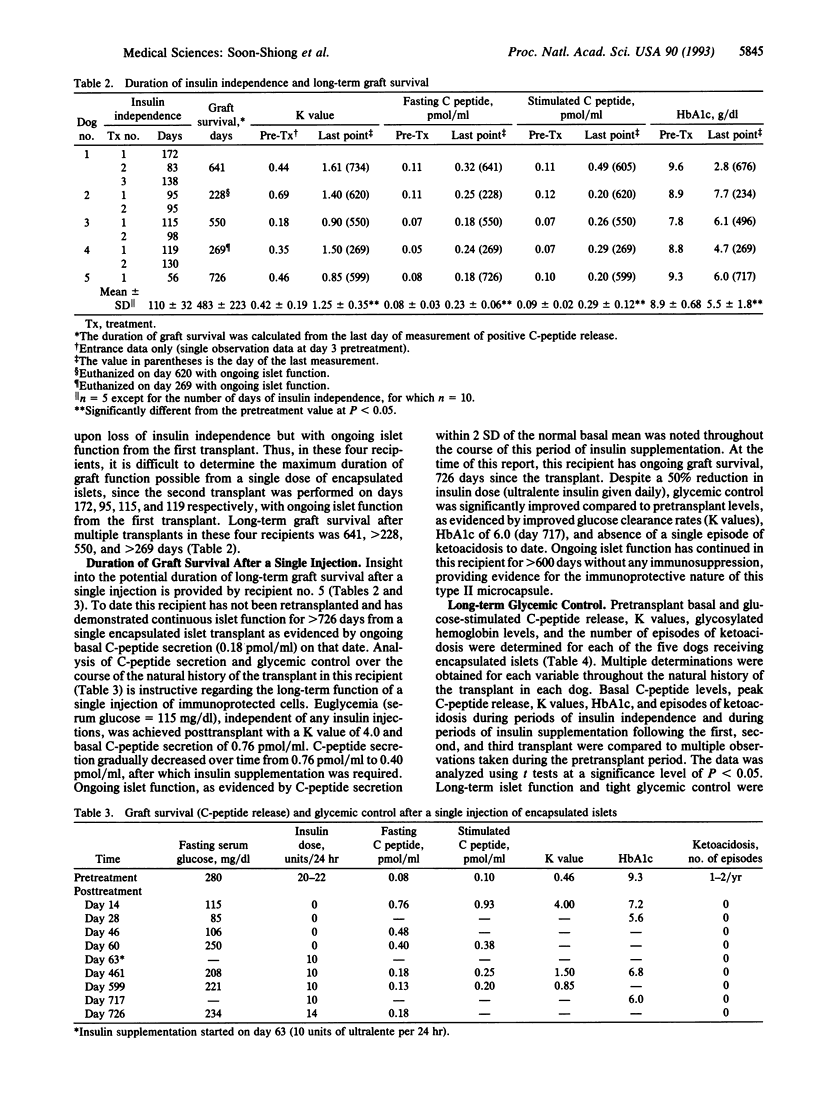
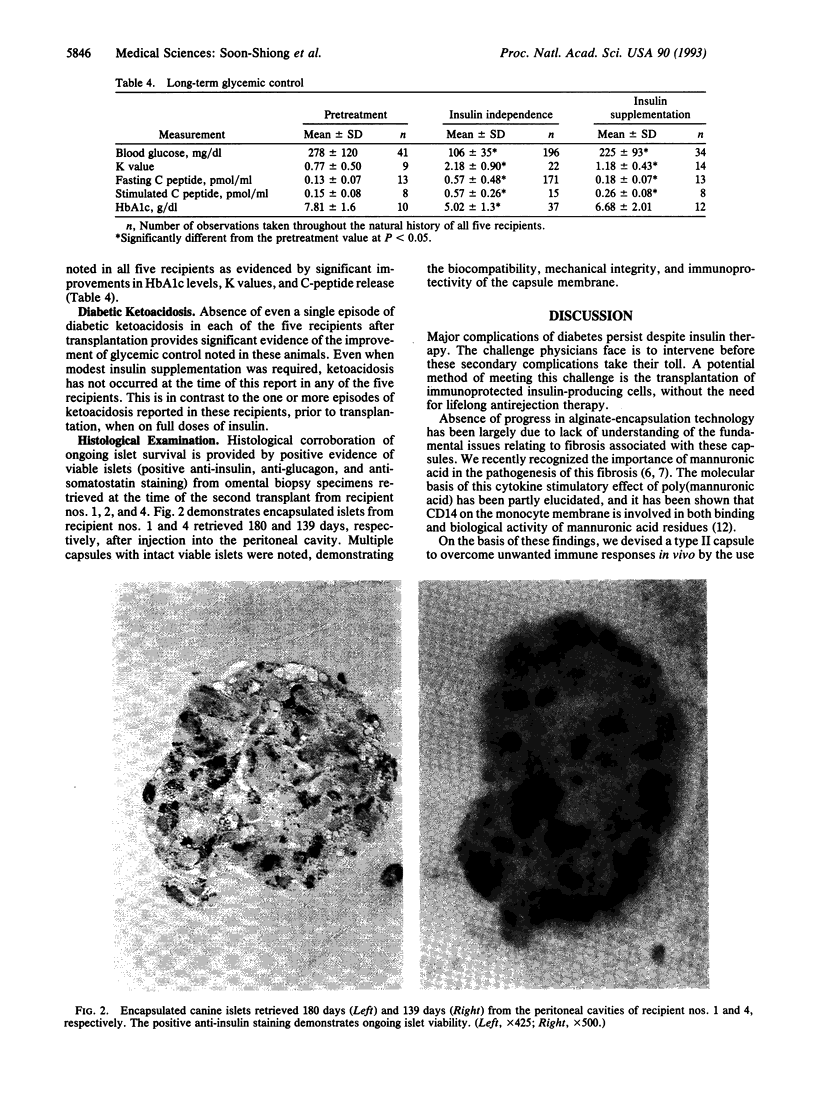
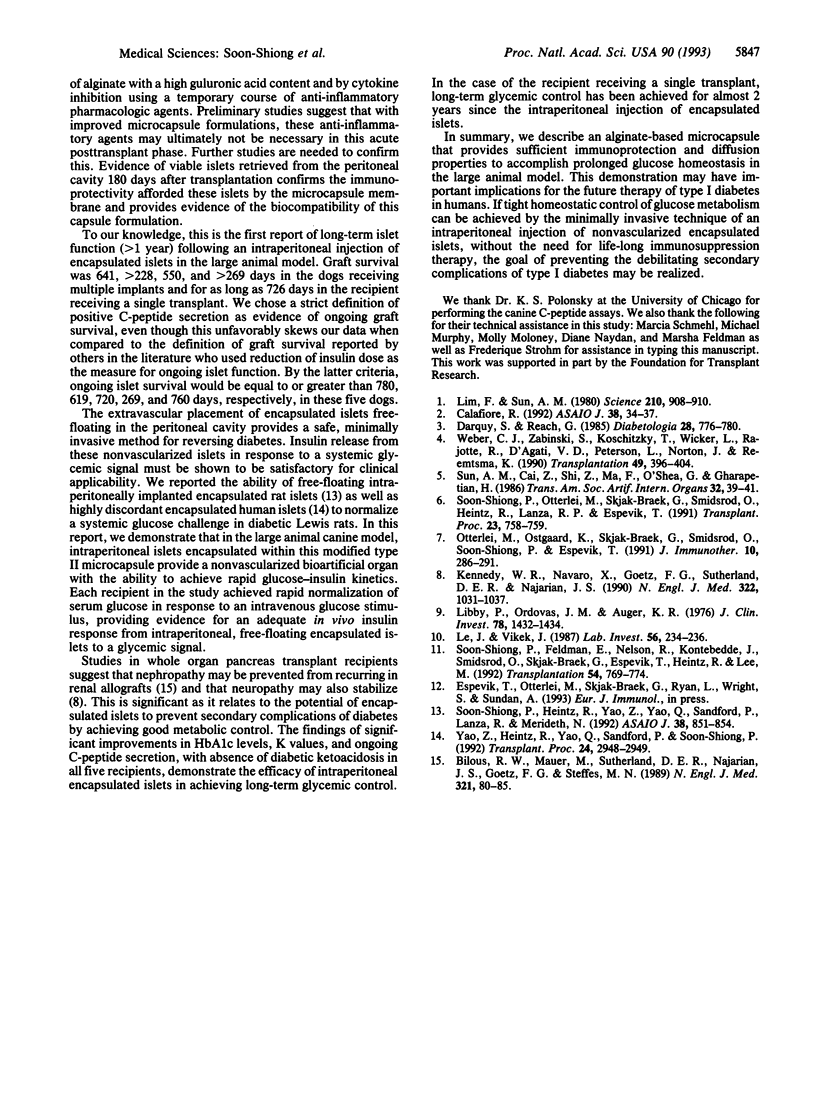
Images in this article
Selected References
These references are in PubMed. This may not be the complete list of references from this article.
- Bilous R. W., Mauer S. M., Sutherland D. E., Najarian J. S., Goetz F. C., Steffes M. W. The effects of pancreas transplantation on the glomerular structure of renal allografts in patients with insulin-dependent diabetes. N Engl J Med. 1989 Jul 13;321(2):80–85. doi: 10.1056/NEJM198907133210204. [DOI] [PubMed] [Google Scholar]
- Calafiore R. Transplantation of microencapsulated pancreatic human islets for therapy of diabetes mellitus. A preliminary report. ASAIO J. 1992 Jan-Mar;38(1):34–37. doi: 10.1097/00002480-199201000-00009. [DOI] [PubMed] [Google Scholar]
- Darquy S., Reach G. Immunoisolation of pancreatic B cells by microencapsulation. An in vitro study. Diabetologia. 1985 Oct;28(10):776–780. doi: 10.1007/BF00265027. [DOI] [PubMed] [Google Scholar]
- Kennedy W. R., Navarro X., Goetz F. C., Sutherland D. E., Najarian J. S. Effects of pancreatic transplantation on diabetic neuropathy. N Engl J Med. 1990 Apr 12;322(15):1031–1037. doi: 10.1056/NEJM199004123221503. [DOI] [PubMed] [Google Scholar]
- Le J., Vilcek J. Tumor necrosis factor and interleukin 1: cytokines with multiple overlapping biological activities. Lab Invest. 1987 Mar;56(3):234–248. [PubMed] [Google Scholar]
- Libby P., Ordovas J. M., Birinyi L. K., Auger K. R., Dinarello C. A. Inducible interleukin-1 gene expression in human vascular smooth muscle cells. J Clin Invest. 1986 Dec;78(6):1432–1438. doi: 10.1172/JCI112732. [DOI] [PMC free article] [PubMed] [Google Scholar]
- Lim F., Sun A. M. Microencapsulated islets as bioartificial endocrine pancreas. Science. 1980 Nov 21;210(4472):908–910. doi: 10.1126/science.6776628. [DOI] [PubMed] [Google Scholar]
- Otterlei M., Ostgaard K., Skjåk-Braek G., Smidsrød O., Soon-Shiong P., Espevik T. Induction of cytokine production from human monocytes stimulated with alginate. J Immunother (1991) 1991 Aug;10(4):286–291. doi: 10.1097/00002371-199108000-00007. [DOI] [PubMed] [Google Scholar]
- Soon-Shiong P., Feldman E., Nelson R., Komtebedde J., Smidsrod O., Skjak-Braek G., Espevik T., Heintz R., Lee M. Successful reversal of spontaneous diabetes in dogs by intraperitoneal microencapsulated islets. Transplantation. 1992 Nov;54(5):769–774. doi: 10.1097/00007890-199211000-00001. [DOI] [PubMed] [Google Scholar]
- Soon-Shiong P., Heintz R., Yao Z., Yao Q., Sanford P., Lanza R. P., Meredith N. Glucose-insulin kinetics of the extravascular bioartificial pancreas. A study using microencapsulated rat islets. ASAIO J. 1992 Oct-Dec;38(4):851–854. [PubMed] [Google Scholar]
- Soon-Shiong P., Otterlie M., Skjak-Braek G., Smidsrod O., Heintz R., Lanza R. P., Espevik T. An immunologic basis for the fibrotic reaction to implanted microcapsules. Transplant Proc. 1991 Feb;23(1 Pt 1):758–759. [PubMed] [Google Scholar]
- Sun A. M., Cai Z., Shi Z., Ma F., O'Shea G. M., Gharapetian H. Microencapsulated hepatocytes as a bioartificial liver. ASAIO Trans. 1986 Jul-Sep;32(1):39–41. [PubMed] [Google Scholar]
- Weber C. J., Zabinski S., Koschitzky T., Wicker L., Rajotte R., D'Agati V., Peterson L., Norton J., Reemtsma K. The role of CD4+ helper T cells in the destruction of microencapsulated islet xenografts in nod mice. Transplantation. 1990 Feb;49(2):396–404. doi: 10.1097/00007890-199002000-00034. [DOI] [PubMed] [Google Scholar]
- Yao Z., Heintz R., Yao Q., Sandford P., Soon-Shiong P. Human C-peptide response in xenotransplanted diabetic Lewis rats. Transplant Proc. 1992 Dec;24(6):2948–2949. [PubMed] [Google Scholar]



